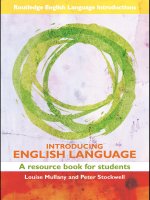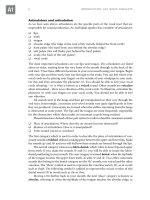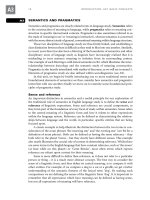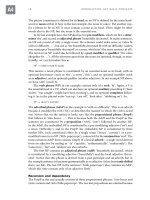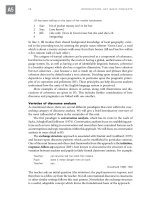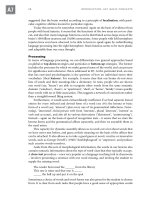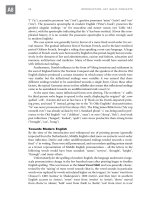Introdungcing English language part 4 ppsx
Bạn đang xem bản rút gọn của tài liệu. Xem và tải ngay bản đầy đủ của tài liệu tại đây (345.56 KB, 6 trang )
4 INTRODUCTION: KEY BASIC CONCEPTS
Articulators and articulation
As we have seen above, articulators are the specific parts of the vocal tract that are
responsible for sound production. An individual speaker has a number of articulators:
q lips
q teeth
q tongue
q alveolar ridge (the ridge in the roof of the mouth, behind the front teeth)
q hard palate (the hard bony area behind the alveolar ridge)
q soft palate (the soft fleshy part behind the hard palate)
q uvula (the back of the soft palate)
q vocal cords
The most important articulators are our lips and tongue. The articulators are listed
above in order, starting from the very front of the mouth through to the back of the
oral tract. Trace these different locations in your own mouth using your tongue. Begin
with your lips and then work your way through to the uvula. You can feel where your
vocal cords are by placing your fingers on the outside of your windpipe in your neck.
Do this and then articulate the phoneme /z/. You should be able to feel your vocal
cords vibrating – /z/ is what is known as a voiced sound. Other sounds are voiceless
when articulated – there is no vibration of the vocal cords. To illustrate, articulate the
phoneme /s/ with your fingers on your vocal cords. You should not be able to feel
any vibration.
All sounds start in the lungs and then get manipulated on their way through the
oral tract. Interestingly, consonant and vowel sounds vary quite significantly in how
they are produced. Consonants are formed when the airflow stemming from the lungs
is obstructed at some point. The lips and the tongue are most frequently responsible
for the obstruction which then results in consonant sounds being realised.
Phoneticians have devised a three-part system in order to describe consonant sounds:
q Place of articulation: Where does the air stream become obstructed?
q Manner of articulation: How is it manipulated?
q Is the sound voiced or voiceless?
The first category which is used in order to describe the place of articulation of con-
sonant sounds is bilabial, defined as taking place between the upper and lower lips. Make
the sounds /p/ and /b/ and you will feel how these sounds are formed through the lips.
The second category is known as labio-dental, which refers to lower lips and upper
front teeth. If you make the sounds /f/ and /v/, you will be able to locate the labio-
dental positioning in your mouth. The next category is termed dental, when the tip/blade
of the tongue touches the upper front teeth, as with /t/ and d/. Two other consonant
sounds that belong to the dental category are the ‘th’ sounds, one voiced and the other
voiceless. The ‘theta’ symbol is used to represent the voiceless variety /0/, as in words
such as thigh. The following symbol is utilised to represent the voiced version of this
dental sound /q/ in words such as the or thus.
Moving a bit further back in your mouth, the next ‘place’ category is known as
alveolar, referring to when the tip/blade of the tongue touches the alveolar ridge, as
PHONETICS AND PHONOLOGY 5
in the sounds /s/ and /z/. A palatal refers to when the front of the tongue touches the
hard palate, as in /j/. Velar refers to when the back of the tongue touches the soft
palate, as in /k/ and /g/.
The final place of articulation is the glottal category, which we have already come
across, referring to the glottis. In addition to the glottal stop, /h/ is the only other sound
which is made in the glottis area. The /h/ sound is made when the glottis is open.
In terms of manner of articulation, the first consonant category is called a stop,
where articulators are closed for a short time and then let go quickly, as with /p/ and
/b/. Make these sounds again, this time thinking about the manner in which your articu-
lators are working.
The second category is known as a nasal, where air escapes through the nose instead
of the mouth, as in /m/ or /n/. Try pinching your nose and saying these, and you will
find it impossible.
The next category is termed fricative, which refers to occasions when the
articulators are closed, so the air has to squeeze through a small opening, resulting in
a ‘hissing’ noise, as in /f/ or /v/.
Approximant is the next category, referring to when turbulence occurs due to
articulators being close together, as with /j/ or /w/. These sounds are sometimes referred
to as glides, as they are made with the tongue in motion, gliding between different
sounds.
Next is lateral approximant, a sub-category of approximant, referring to when
air flows out through the side of the tongue, as with /l/.
Finally, the affricate category refers to a brief stop followed by a slow release of
air, with the speech organs lingering in the fricative position for a time, as in the
‘ch’ sounds in cheese, represented by the phonemic symbol /tt/ (see B1 for further
details).
In contrast to consonants, vowels are not related to obstruction and there is no
need to decide whether vowels are voiced or voiceless, as all vowels are voiced – it is
impossible to produce a vowel sound without the vocal cords vibrating. Also, all
vowels are approximants, so it is not possible to use the manner category for distin-
guishing between different vowel sounds. In terms of place of articulation, vowels are
always produced in the oral cavity. Different vowel sounds are made by varying the
positioning of the tongue and the lips.
Therefore, instead of the system used for consonant description, the identi-
fication for vowel sounds focuses upon the following:
q the shape of the tongue
q the positioning of the lips
q whether the tongue and lips are kept still or whether they change position during
sound production
q how long the sound is made for, known as duration.
To aid the process of description, phoneticians have devised a diagrammatic map of
the tongue which is designed to trace these features. Such maps are commonly
referred to as vowel trapeziums. We will look at examples of these trapeziums in B1
as part of our more detailed consideration of vowels and consonants.
SWIN|KCrEIB1Qqc8svpQueSEh0w==|1282035698
6 INTRODUCTION: KEY BASIC CONCEPTS
MORPHOLOGY AND LEXICOLOGY
What is a word?
Most non-linguists would say that a word is the smallest chunk of meaningful
language, a unit made up only of individually meaningless sounds (if spoken) or let-
ters (if written). Certainly, most linguists would agree that phonemes (speech sounds,
introduced in A1) and graphemes (written letters) in themselves usually do not have
a meaning: the phonemes /t/, /a/, the diphthong /ai/, the cluster /lt/, the grapheme
‘g’, and the digraphs (two-letter groups) ‘th’ and ‘gh’ are meaningless in isolation.
However, there are many words in this paragraph that are not neatly unitary. For
example, the word ‘themselves’ seems to be made up of two smaller words ‘them’ +
‘selves’ – here, the two composite words are proper words in their own right.
‘Certainly’, though, seems to be made up of a word in its own right (‘certain’) and
another odd addition (‘-ly’) that cannot really stand on its own.
‘Meaningless’ can similarly be divided into two (‘meaning’ + ‘-less’); we could even
go further and divide it into three (‘mean’ + ‘-ing’ + ‘-less’), though not four (the unit
‘mean’ here is not composed of the senses of ‘me’ and ‘an’). By contrast again, ‘how-
ever’ can be divided into two other words that can stand on their own (‘how’ + ‘ever’),
but it does not seem clear how the meaning of ‘however’ can exactly be determined
by the meanings of these two words.
Other words in the paragraph have been formed by hyphenating two words together
(‘non-linguists’, ‘co-text’), or by taking small chunks that were originally meaningful
in other languages (‘phon’, ‘eme’, ‘graph’, ‘para’), or by adapting words from other
meaningful contexts so that they can only be metaphorical (how do words literally
‘stand on’ their own?), or by formulaic phrases that seem to mean more than the sum
of their parts (‘made up’). If we said that we wrote that first paragraph deliberately
to lead you up the wrong path, to pull the wool over your eyes, to throw you a red
herring, or to convey antinormalisationness, you can probably guess what we mean,
but if you are a beginning learner of English, an elementary word-for-word translating
dictionary will be pretty hopeless.
Words and their parts
The notion of a word is therefore not particularly straightforward, and linguists
prefer to use the term morpheme for the smallest meaningful units of language.
‘Certain’, ‘mean’ and ‘linguist’, in the examples above, are all free morphemes – free
because they can stand on their own as fully fledged words. The others are bound
morphemes – bound because they can only survive meaningfully by being attached
to free morphemes: ‘-ly’, ‘-ing’, ‘-ise’, -‘ation’, ‘-less’, ‘non-’, ‘co-’, and so on are all
bound morphemes.
You can take any word in English and decide whether it is made up of one or
more morphemes. You can also tell a lot about the meaning and use of the word by
understanding which of its constituent morphemes are free or bound.
Notice that it is the meaning of these units that is most important, rather than how
they look or sound: the written versions of ‘phone’ and ‘none’ change their shapes when
attached to other morphemes (losing their final ‘e’ in, for example, ‘phonological’
or ‘nonsense’). Similarly, words can change their sounds (listen to the differences when
A2
MORPHOLOGY AND LEXICOLOGY 7
‘use’ is combined to make ‘usually’ (/s/ or /z/ → /n/), ‘composite’ to ‘composition’
(/t/ → /t/), and even ‘formula’ to ‘formulaic’ (/e/ → /™x/). Clearly, phonetic and
graphological quality is secondary to morphology here.
Morphology (the study of these elementary units and their rules of combination)
is traditionally divided into two areas: grammatical inflection and word-formation
(the latter area increasingly the concern of the field known as lexicology). Inflections
are when a bound morpheme is added whose main purpose is to alter the grammat-
ical category of the free morpheme. So the free morpheme ‘look’ can be connected to
other, bound morphemes to produce ‘looks’ (as plural), ‘looks’ (as third person verb-
form), ‘looking’ (present participle), and ‘looked’ (past participle). These additional
morphemes are all suffixes – they follow the root word.
Most English grammatical morphemes are suffixes, though in the past English has
had past-marker prefixes (‘yronne’ = ran), reflexive prefixes (‘methinks’), and pos-
sessive prefixes (‘akin’, ‘afresh’). See if you can find any more of these.
English also used to have a great many infixes, where the bound morpheme occurs
in the middle of the root word, preserved in modern usage as ‘strong’ forms of the
past tense (‘run – ran’, ‘bring – brought’, ‘steal – stole’). These three forms of affix
all serve a grammatical purpose, by contrast with non-inflectional affixes such as
‘un-’, ‘in-’, ‘re-’, ‘-ly’, ‘-ness’, ‘-isation’, ‘-wise’, and so on. These last examples of
word-forming affixes are very rarely infixed, except for creative oddities like
‘absobloodylutely’.
Word-formation is the most productive area of morphology. The addition of non-
inflectional affixed morphemes is a form of derivation: so from the root word ‘help’
English has derived ‘helpful’, ‘unhelpful’, ‘helpless’, ‘helplessness’, ‘helper’, and could
conceivably derive others with a bit of creativity, such as ‘helperwise’ (pertaining to
assistants), ‘rehelp’ (to fill one’s plate again), ‘dishelp’ (to hinder more strongly than
‘unhelpful’), ‘helpily’ (cheerful assistance), and so on. The root word (‘look’, ‘help’,
‘run’, ‘steal’) is called the lemma – the form you would look up in a dictionary.
Derivation has produced many new word-forms in English. Zero-derivation is where
the word does not change shape but nevertheless comes to be used as a new word:
verbification is particularly common in English, from Shakespeare’s first usage of ‘knife’
as a verb rather than a noun (see B4 for definitions of terms), to more recent ‘access
the file’, ‘chair the meeting’, ‘talk the talk’, or ‘green your politics’.
Where two or more free morphemes are combined, this phenomenon of word-
formation is compounding, and, as in other basically Germanic languages, it is very
common in English. Formulaic phrases (‘red herring’, ‘head waiter’, ‘climate
change’), hyphenations (‘self-harm’, ‘role-play’, ‘after-effects’), true compounds
(‘phonebox’, ‘whiteboard’, ‘sportscar’), and lexical blends (‘digibox’, ‘cyborg’,
‘smog’) are all examples of compounding. Notice that the compounded elements can
be from different parts of speech (noun + noun, or noun + verb, or adjective + noun,
and so on, see A4), and can even mix languages (‘über-chic’ German and French, ‘tele-
port’ Greek and Latin).
Adopting and adapting words
It should be evident from these diverse sources that English has been particularly open
across its 1500-year history to borrowing (perhaps better understood as copying or
8 INTRODUCTION: KEY BASIC CONCEPTS
even as stealing). English began as a Germanic dialect with Scandinavian contact (so
we have ‘apple’, ‘tree’, ‘sky’, ‘skirt’), in a Celtic landscape (‘tor’, ‘banner’, ‘slogan’),
followed by Norman French influence and French borrowing over 500 years
(‘parliament’, ‘mutton’, ‘administration’), with Italian, Latin and Greek loans through
the Renaissance and continuing with the scientific Enlightenment (‘pasta’, ‘violin’,
‘oxygen’, ‘catalyst’, ‘microcomputer’).
French, Germanic languages and Latin account in almost equal measures for most
common English words, with everyday speech weighted towards Germanic vocabu-
lary and formal or technical language leaning more towards French and Latin
sources. Other borrowings include ‘caravan’ (Persian), ‘juggernaut’ (Sanskrit), ‘sushi-
bar’ (Japanese), ‘lager’ (German), and from Bantu languages ‘safari’, ‘zombie’,
‘jumbo’ and ‘a-go-go’; from Arabic ‘alcohol’, ‘algebra’, ‘zero’, ‘tariff ’, ‘magazine’;
from Portuguese ‘teak’, ‘zebra’, ‘marmalade’, ‘palaver’; and from the native American
languages ‘papoose’, ‘shack’, ‘barbecue’, ‘canoe’ and ‘cocaine’.
When borrowing from other languages, English has tended to anglicise the
pronunciation, which is often reflected in the spelling: ‘vindaloo’ curry from the
Portuguese ‘carne de vinha d’alhos’; ‘cafe’ often appears without the French acute accent
on the final letter (‘café’), and sometimes gets pronounced [kaf] or [kafi], without a
French accent at all (see B1 for further details on how to write in phonetic notation).
There are some exceptions, of course, such as ‘chic’, which retains its French sound
(perhaps both because of its haute couture sense and also because of a clash with ‘chick’).
When words are borrowed into English, they usually tend to become grammatically
fixed for inflections too: so we might order two ‘pizzas’ rather than ‘pizze’, eat two
mint ‘Magnums’ (ice lollies) instead of ‘Magna’, and talk about ‘schemas’ not
‘schemata’. There is even a great deal of debate over whether the plural of the com-
puter ‘mouse’ is the modern inflection ‘mouses’ rather than the medieval ‘mice’.
When words are borrowed, as in some examples above, the source words are often
shortened. Shortening in itself is also a form of word-formation. We have ‘mobs’ not
‘mobiles’, ‘fans’ more usually than ‘fanaticks’, and modern life has the ‘telly’, the ‘phone’,
the ‘flu’, the ‘gym’, the ‘car’, the ‘bus’, the ‘pram’, the ‘fridge’ and many more, all
clipped from longer original words. These are all abbreviations of various forms, and
often the longer and shorter versions coexist for a long time in the language, with
the shorter form being colloquial and the longer form reserved for formal or technical
contexts.
Shortening in the form of acronyms is very common, especially in technological
innovation: the LP was replaced by the CD and DVD, then MP3. Acronyms can be
atomic if each element is pronounced separately (FBI, BBC, EU, RAF) or molecular if
pronounced as a genuine word (‘laser’, ‘radar’, ‘NASA’). Occasionally a combination
of processes of word-formation results in historical oddities. The most famous is
the ‘hamburger’, originally invented in Hamburg, New York and made from beef
with coffee and spices between bread. The ‘ham’ morpheme is wrongly associated with
meat and so is regarded as detachable from the whole word, producing the back-
formation ‘burger’. This free morpheme is then available to be compounded with many
other prefixes: ‘cheeseburger’, ‘veggie-burger’, ‘BBQ-burger’, ‘tofu-burger’, plain ‘burger’
and even the wrongly corrected ‘beefburger’.
MORPHOLOGY AND LEXICOLOGY 9
Similarly, the verb ‘to burgle’ was wrongly back-formed from ‘burglar’ in the late
nineteenth century (as if the suffix was the morpheme ‘-er’, denoting the doer of the
action), probably from the Middle English ‘burgh-breche’ and ‘burgator’ (home-breaker).
American usage suffixed the morpheme in ‘burglarized’. Other back-formations include
‘auto-destruct’ (rather than ‘destroy’, from ‘auto-destruction’), ‘bicep’ (from ‘biceps’),
‘pant’ (from ‘pants’), and ‘trouser’, ‘peddle’ (from ‘peddler’ or ‘pedlar’), ‘sleaze’ (from
‘sleazy’), ‘transcript’ (from ‘transcription’), ‘televise’ (from ‘television’), and many others.
Related to these forms are retronyms, which are words created anachronistically
in response to later developments. For example, the ‘acoustic guitar’ was just any old
guitar until the invention of the ‘electric guitar’. Similarly, ‘World War I’ was just ‘the
Great War’ until ‘World War II’. Others include ‘landline’ (before mobile cellular phones),
‘analogue’ (meaning anything pre-digital), ‘vinyl’ (to describe what used to be
simply ‘records’), and so on.
New words
Quite unusually, words can be formed simply by creation out of nowhere. Genuinely
novel creations are hard to identify, however, since they usually conform to standard
phonological rules of English and so will always be suggestive of some source or other,
and many neologisms (new coinages of words) are formed from other existing
words. Literary and science fictional texts are good sources for creative neologisms,
but the origins of ‘warp-drive’, ‘raygun’, ‘flying saucer’ and ‘cyborg’ are plain or
easily deducible. More obscure neologisms might include ‘kemmer’ (Ursula Le
Guin’s invention of the reproductive period of an alien race), ‘grok’ (Robert
Heinlein’s wide-ranging term for mutual empathy), and Philip K. Dick’s very useful
‘kipple’ (the bits and pieces of detritus that accumulate and multiply over time in
drawers and cupboards).
Of course, all the various types and combinations of word-formation can be extended
by grammatical inflection as well. So the verb ‘to grok’ can be inflected to produce
‘I grok’, ‘she groks’, ‘we grokked’, ‘they are grokking’, and the noun ‘raygun’ can be
inflected as ‘two rayguns’, as well as expanded by derivation as in ‘the raygunner’,
‘raygunnery’, ‘anti-raygun’, and so on.
Over the course of the development of English, most new words in the language
have been free morphemes borrowed from other languages or adapted from existing
words as set out above. Innovation in new grammatically bound morphemes is very
rare: the Old English third-person verb-ending ‘-e2’ lasted into Middle English
(spelled as ‘-eth’, as in ‘my cup runneth over’), but the northern dialectal ‘-s’ ending
eventually replaced it (‘runs over’). There have to be very powerful, long-lasting and
widespread forces to sustain a new grammatical morpheme. For example, the pro-
noun ‘it’ (from Old English ‘hit’) was originally a useful option between ‘he’ and ‘she’
(originally ‘he’ and ‘heo/seo’ in Old English), but today ‘it’ has a sense of inanimacy.
It would be very useful in modern English to have a less clumsy neutral option other
than ‘he or she’ or the written ‘s/he’ or the increasingly common but odd non-
agreement of ‘they’ in a sentence like, ‘when the reader gets to this point, they will
have finished the unit’. Perhaps you might try to invent or import a useful alternative
pronoun?
